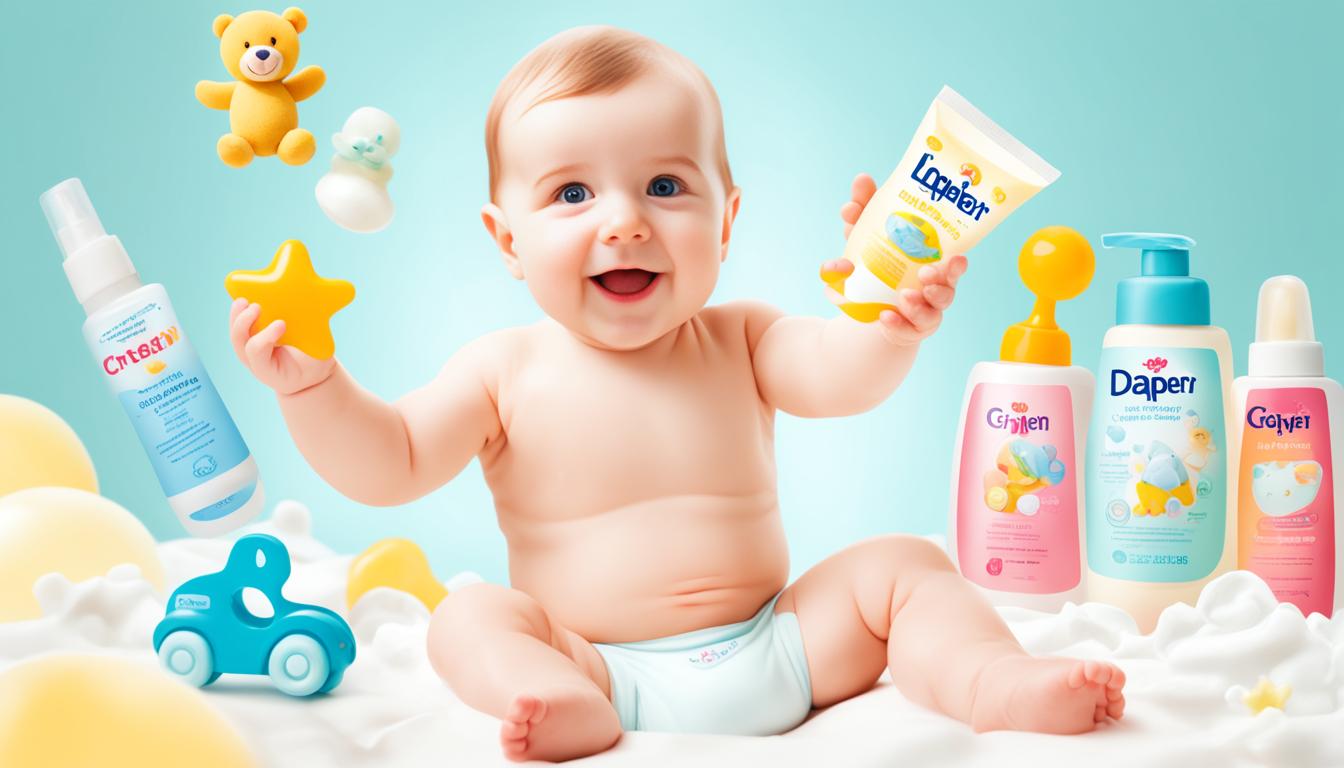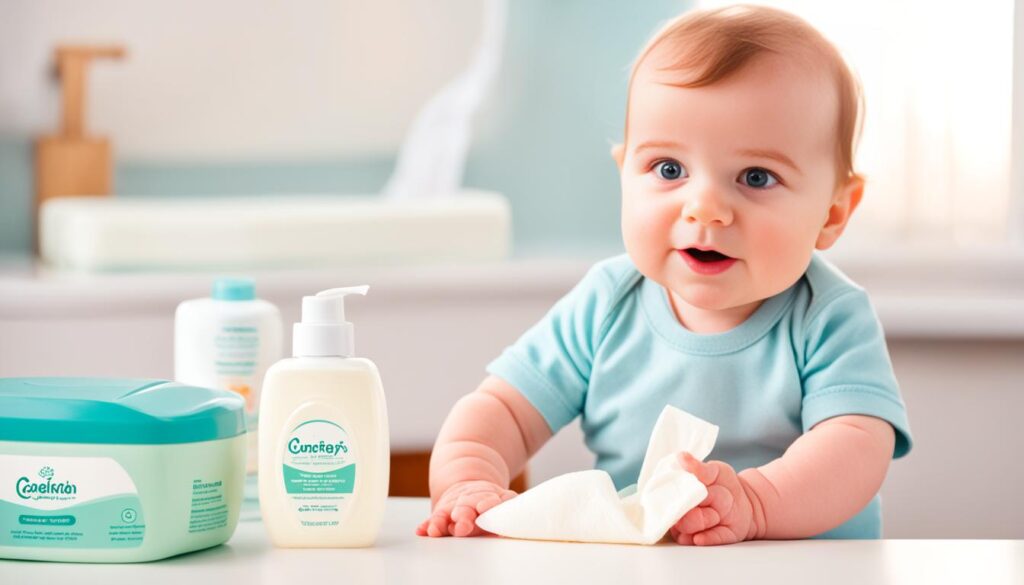Hello, parents! Taking care of your baby’s delicate skin is a top priority, and diaper rash is a common concern many of us face. To ensure your little one stays comfortable and rash-free, it’s important to know when and how to use diaper rash cream effectively. In this article, I’ll guide you through the best practices for diaper rash prevention and treatment.
Key Takeaways:
- Starting diaper rash cream from the first diaper change is recommended for both prevention and treatment.
- Diaper rash can be caused by factors such as prolonged exposure to wet diapers, friction, infections, allergies, or irritants in diapers.
- Prevention measures include frequent diaper changes, proper cleansing, thorough drying, and using mild wipes or plain water.
- Applying diaper rash cream in a thick layer, covering the entire diaper area, helps soothe and protect your baby’s skin.
- If diaper rash persists or worsens, seek medical help within 24 hours to prevent complications.
Understanding Diaper Rash
Diaper rash is a common skin condition that affects many babies. It can cause discomfort and irritation, making it essential to understand its causes, preventive measures, and appropriate treatment options.
Several factors can contribute to diaper rash, including:
- Prolonged exposure to wet or dirty diapers
- Friction from the diaper
- Yeast or bacterial infections
- Allergies
- Irritants in diapers or wipes
By identifying the causes of diaper rash, you can take proactive steps to minimize its occurrence. Ensuring proper baby skincare, such as frequent diaper changes, gentle cleaning, and using quality diapers and wipes, can significantly reduce the risk of diaper rash.
When it comes to choosing the appropriate treatment for diaper rash, it is crucial to consult with your pediatrician. They can provide personalized advice and recommend products suitable for your baby’s specific skin needs.
The Importance of Diaper Rash Prevention
Prevention is key when it comes to diaper rash. As a parent, taking proactive steps to keep your baby’s skin healthy and rash-free is essential for their overall well-being. By following proper diaper changing tips, you can minimize the risk of diaper rash and ensure your baby stays happy and comfortable.
Here are some diaper changing tips to help prevent diaper rash:
- Frequent diaper changes: Regularly changing your baby’s diaper is crucial for maintaining good hygiene and preventing diaper rash. Aim for at least every two to three hours, or more frequently if needed.
- Gentle cleansing: When changing your baby’s diaper, use warm water or mild baby wipes to gently clean their bottom. Avoid using harsh soaps or wipes that contain irritants.
- Allowing the skin to dry: After cleaning your baby’s bottom, make sure to let their skin air-dry completely before putting on a fresh diaper. Moisture can contribute to the development of diaper rash, so give their skin some time to breathe.
By incorporating these diaper changing tips into your routine, you can greatly reduce the chances of your baby experiencing diaper rash. Remember, prevention is always better than cure, and taking care of your baby’s skin health is crucial for their overall health and happiness.
“Prevention is always better than cure, and taking care of your baby’s skin health is crucial for their overall health and happiness.”
When to Start Using Diaper Rash Cream
As a parent, one of your top priorities is keeping your baby comfortable and protected, especially when it comes to their delicate skin. That’s why it’s important to know when to start using diaper rash cream to prevent any discomfort or irritation. Starting from the very first diaper change, it is recommended to apply a thick layer of a zinc oxide barrier cream, such as DESITIN® Maximum Strength Original Paste or DESITIN® Rapid Relief Cream.
Using diaper rash cream consistently can help soothe and protect your baby’s skin from the potential causes of diaper rash. By creating a protective barrier, the cream can shield your baby’s delicate skin from wetness, friction, and irritants that may be present in diapers or wipes. By applying diaper rash cream at each diaper change, you can help prevent diaper rash from occurring or worsening.
Choose a Trusted Diaper Rash Cream
When selecting a diaper rash cream, it’s important to choose a trusted brand that is specifically formulated for diaper rash prevention and treatment. DESITIN® Maximum Strength Original Paste and DESITIN® Rapid Relief Cream are two well-known and effective options. These creams contain zinc oxide, a key ingredient that can help soothe and protect your baby’s delicate skin.
The DESITIN® line of diaper rash creams is designed to provide fast relief and prevent diaper rash from occurring. Their maximum strength formula and rapid relief formula both offer different benefits, so you can choose the best option for your baby’s needs.
“I started using DESITIN® diaper rash cream from day one with my little one, and it has been a game-changer. Not only does it protect her skin, but it also provides quick relief from any signs of irritation. It’s an essential part of our diaper changing routine!” – Parent testimonial
Remember, consistency is key when it comes to using diaper rash cream. By incorporating it into your daily diaper changing routine, you can help keep your baby’s skin healthy and free from diaper rash. If you have any concerns or questions about diaper rash or the appropriate use of diaper rash cream, it’s always a good idea to consult with your pediatrician.
Take a look at the image below to see the DESITIN® Maximum Strength Original Paste, a trusted diaper rash cream:
Continue reading to learn more about how to apply diaper rash cream effectively and the different types of diaper rash that can occur.
How to Apply Diaper Rash Cream
When it comes to protecting your baby’s delicate skin, applying diaper rash cream correctly is essential. By following these simple steps, you can ensure that your little one stays comfortable and free from diaper rash.
To begin, make sure you clean and dry your baby’s bottom thoroughly. You can use lukewarm water or gentle wipes to cleanse the area gently. Patting the skin dry with a soft towel or letting it air dry is equally effective.
Once the skin is clean and dry, it’s time to apply the diaper rash cream. Choose a cream that contains zinc oxide, as it creates a protective barrier on the skin, reducing friction, blocking wetness, and protecting against irritants.
Generously apply the cream onto your baby’s bottom, making sure to cover the entire diaper area. Remember, a thick layer ensures maximum protection. Avoid rubbing the cream into the irritated skin, as this can cause further discomfort.
“Applying diaper rash cream is a crucial part of baby skincare. By creating a protective barrier, the cream helps prevent diaper rash by reducing friction and blocking wetness.” – Dr. Lisa Anderson, pediatrician
Once the cream is applied, you can proceed with diapering your baby as you normally would. Don’t forget to change their diaper regularly and follow proper diaper changing techniques to maintain good hygiene.
It’s important to note that diaper rash creams are meant for external use only. Avoid applying them to open wounds or broken skin. If your baby’s diaper rash persists or worsens despite your efforts, it’s best to consult your pediatrician for further guidance and treatment options.
Remember, each baby may have different skincare needs. Adjusting your approach and seeking professional advice can help you find the best solutions for your little one’s diaper rash concerns.
Types of Diaper Rash
When it comes to diaper rash, there are various types that can occur. Understanding these different types can help you identify the underlying causes and choose the right treatment options. Let’s take a closer look at the most common types of diaper rash:
Irritant Dermatitis
Irritant dermatitis is the most common type of diaper rash. It is usually caused by prolonged exposure to wet or soiled diapers, which can irritate the delicate skin of your baby’s bottom. The main remedy for irritant dermatitis is to keep your baby’s diaper area clean and dry, and applying a diaper rash cream with soothing ingredients like zinc oxide.
Yeast Diaper Rash
Yeast diaper rash, also known as candidal dermatitis, is caused by an overgrowth of yeast in the diaper area. This type of rash appears as bright red, raised bumps surrounded by redness. Yeast diaper rash may require antifungal cream or ointment prescribed by your pediatrician to effectively treat the infection.
Bacterial Diaper Rash
Bacterial diaper rash is often caused by a bacterial infection, and it can be identified by pustules or boils that are sometimes accompanied by a fever. Antibacterial creams or ointments may be prescribed by your pediatrician to treat the infection and help the rash heal.
Allergic Diaper Rash
Allergic diaper rash occurs when your baby’s skin reacts to certain allergens, such as fragrances, dyes, or chemicals present in diapers or wipes. It can appear as red, scaly patches or tiny red bumps. Identifying and eliminating the allergen is crucial in treating allergic diaper rash. Using hypoallergenic diapers and wipes can also help prevent further irritations.
If you’re unsure about the type of diaper rash your baby has or if the rash doesn’t improve with home remedies, it’s important to consult with your pediatrician for an accurate diagnosis and appropriate treatment plan.
Remember, addressing the underlying cause of the diaper rash is essential for effective treatment. Using the right diaper rash cream and following proper skincare practices can help alleviate discomfort and promote healing for your little one.
How Long Does Diaper Rash Last?
Proper treatment and care are key to resolving diaper rash within 3 days. With the right approach, you can help alleviate your baby’s discomfort and prevent complications.
If the diaper rash persists or worsens, it may indicate a yeast or bacterial infection, and it is important to consult your pediatrician for further guidance. Prompt treatment can expedite the healing process and ensure your baby’s skin health.
Remember, a happy, healthy baby starts with attentive care and effective diaper rash treatment. Don’t hesitate to seek medical advice if needed.
Complications and When to Seek Medical Help
In some cases, diaper rash can lead to complications that require medical attention. It’s important to be aware of these complications and know when to seek professional help for your baby’s health.
Changes in Skin Color
In severe cases of diaper rash, you may notice changes in your baby’s skin color. The affected area may become darker or lighter than the surrounding skin. This discoloration could indicate a more serious underlying issue that needs medical evaluation. Consulting with a pediatrician is recommended in such instances.
Secondary Infections
Diaper rash can also make your baby’s skin more susceptible to secondary infections. If you observe signs of infection, such as bleeding, crusty sores, blisters, or pus-filled lesions, it is crucial to seek medical help immediately. Delaying treatment can lead to further complications and discomfort for your baby.
“When your baby’s diaper rash shows signs of bleeding, crusty sores, blisters, or oozing pus, it’s important to consult with a pediatrician within 24 hours for appropriate treatment and guidance.”
Diaper rash treatment should not be taken lightly. If the above complications arise, seeking medical help promptly is essential for your baby’s health and well-being. Your pediatrician can assess the severity of the condition, provide appropriate treatment options, and offer guidance to help prevent future occurrences.
Tips for Diaper Rash Prevention
Along with using diaper rash cream, there are additional steps you can take to prevent diaper rash. By incorporating these preventive measures into your baby’s skincare routine, you can minimize the chances of diaper rash occurring.
Frequent Diaper Changes
Regular diaper changes are essential for maintaining your baby’s skin health. Change wet or soiled diapers promptly to prevent prolonged exposure to moisture, which can irritate the skin and lead to diaper rash.
Gentle Cleansing
When it’s time for a diaper change, use gentle methods to cleanse your baby’s bottom. Opt for plain water or mild wipes specifically designed for sensitive baby skin. Avoid using harsh soaps or wipes with fragrances, as they can further disrupt the skin’s natural balance.
Adequate Skin Drying Time
After cleaning your baby’s skin, ensure that it is thoroughly dry before putting on a fresh diaper. Moisture trapped against the skin can create a breeding ground for bacteria and yeast, increasing the risk of diaper rash.
Use Mild Wipes or Plain Water
When wiping your baby’s bottom, choose wipes that are alcohol-free and hypoallergenic to minimize the likelihood of skin irritation. Alternatively, you can also use plain water and a soft cloth or cotton pads for gentle cleansing.
Avoiding Tight Diapers
Select diapers that fit your baby properly without being overly tight. Snug but comfortable diapers allow for better airflow and reduce friction against the skin, decreasing the chances of diaper rash.
Letting Your Baby Go Diaper-Free
Whenever possible, give your baby some time without a diaper. Allowing their skin to breathe and be exposed to fresh air can be beneficial for preventing diaper rash. Lay a waterproof mat or towel in a safe area and let your little one explore freely.
By following these diaper rash prevention tips and using diaper rash cream as a preventive measure, you can help keep your baby’s skin healthy and free from uncomfortable rashes.
Home Remedies for Diaper Rash
While commercial diaper rash creams are effective, some parents prefer to try home remedies. These natural alternatives can provide soothing relief for your baby’s irritated skin. However, it is important to note that not all home remedies are scientifically proven, so it’s best to consult with your pediatrician before trying them.
One popular home remedy is using breast milk. Breast milk is known for its healing properties and can help reduce inflammation and promote skin repair. Simply express a few drops of breast milk onto a cotton ball and apply it to your baby’s rash.
Another option is coconut oil. Coconut oil has moisturizing and antimicrobial properties that can help soothe and protect your baby’s delicate skin. Gently massage a small amount of coconut oil onto the affected area.
Witch hazel is a natural astringent that can provide relief from itching and inflammation. Soak a cotton pad with witch hazel and apply it to your baby’s rash. Avoid using witch hazel on broken or open skin.
Baking soda baths are also a popular remedy for diaper rash. Add a tablespoon of baking soda to your baby’s bathwater and let them soak for 10-15 minutes. Baking soda can help balance the pH levels of the skin and reduce irritation.
“Natural home remedies can be a gentle and effective way to soothe your baby’s diaper rash, but be sure to check with your pediatrician for personalized advice and guidance.”

Remember, every baby is different, and what works for one may not work for another. If your baby’s diaper rash persists or worsens, or if you notice any signs of infection, it’s important to seek medical advice. Your pediatrician can provide the best course of treatment for your little one’s specific needs.
Taking Care of Diapers and Laundry
To ensure the well-being of your baby’s sensitive skin, it is essential to keep their diapers and laundry clean. By following some simple tips and maintaining proper hygiene practices, you can help prevent diaper rash and promote your baby’s overall health.
- Regular diaper changes: Changing your baby’s diaper frequently is crucial for preventing diaper rash. Wet or soiled diapers can irritate the skin and increase the risk of developing a rash. Aim to change your baby’s diaper every two to three hours, or whenever it becomes wet or soiled.
- Choosing mild detergents: When washing your baby’s cloth diapers or clothing, opt for mild detergents that are free from harsh chemicals and fragrances. These detergents are less likely to cause skin irritation and are gentle on your baby’s delicate skin.
- Avoiding cornstarch: While cornstarch may seem like a natural remedy for diaper rash, it can actually worsen the condition. Cornstarch can create a moisture-trapping environment, promoting the growth of yeast or bacteria. It is best to avoid using cornstarch on your baby’s skin.
- Proper hygiene practices: When handling dirty diapers, always wash your hands thoroughly with soap and water or use hand sanitizers. This helps prevent the spread of any harmful bacteria or germs. Additionally, ensure that the changing area is clean and sanitized.
By incorporating these diaper changing tips and practicing good hygiene, you can minimize the risk of diaper rash and maintain your baby’s skin health. Remember, prevention is key when it comes to diaper rash, and taking care of your baby’s diapers and laundry is an essential part of that process.
Conclusion
Managing diaper rash is a top priority for parents, and with the right steps, you can effectively prevent and treat it. By prioritizing your baby’s skincare and using diaper rash cream from the very first diaper change, you can create a protective barrier against moisture and irritants. Additionally, following diaper changing tips and maintaining good hygiene practices will contribute to your baby’s overall skin health.
Remember, every baby is different, and if you have any concerns or questions, it’s always best to consult with your pediatrician. They can provide personalized advice tailored to your baby’s specific needs and recommend suitable treatment options if necessary. Your baby’s happiness and comfort are worth investing in their skincare, so take the necessary precautions to keep their delicate skin free from diaper rash.
With proper care, attention, and the use of suitable baby skincare products, you can provide your little one with the best possible protection against diaper rash. Stay vigilant, stay informed, and enjoy the precious moments with your baby, knowing that you are doing everything you can to keep their skin healthy and free from discomfort.


